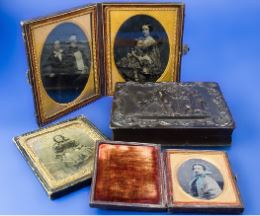Identification and Price guides for Antiques & Collectibles


COLLECTIBLE AMBROTYPES:
How to Research and Appreciate These Historical Treasures
Join the most updated and complete collectibles research online - Learn more...
 Ambrotypes are a type of early photograph produced on glass plates that were popular during the mid-19th century. These images offer a glimpse into the past and have become highly collectible in recent years. If you're interested in learning more about ambrotypes and how to research them, then you've come to the right place. In this article, we'll take a closer look at what makes ambrotypes so special, how to identify them, and tips for researching and valuing them.
Ambrotypes are a type of early photograph produced on glass plates that were popular during the mid-19th century. These images offer a glimpse into the past and have become highly collectible in recent years. If you're interested in learning more about ambrotypes and how to research them, then you've come to the right place. In this article, we'll take a closer look at what makes ambrotypes so special, how to identify them, and tips for researching and valuing them.
What are Ambrotypes?
Ambrotypes were introduced in the 1850s and were popular until the early 1860s. They were created by coating a glass plate with a light-sensitive emulsion and then exposing it to light to capture an image. The resulting image was a positive image on a glass plate, which was then backed with a dark material to create a contrast.
Ambrotypes were popular because they were more affordable than daguerreotypes, an earlier type of photographic process, and were more durable. Ambrotypes were also easier to produce, which made them more accessible to the general public. Ambrotypes were often displayed in ornate cases, which were made of materials such as wood, leather, or metal. The case protected the fragile glass plate and provided a way to display the image.
What Makes Ambrotypes Collectible?
Ambrotypes offer a glimpse into the past and are a tangible connection to history. They provide us with a visual record of people and places from a time long gone. Ambrotypes are also unique, as each one is a one-of-a-kind image that can never be replicated. This uniqueness adds to their value and makes them highly collectible.
Another factor that makes ambrotypes collectible is their scarcity. Because they were only produced for a short period, there are relatively few ambrotypes in existence today. This scarcity drives up their value and makes them a desirable addition to any collection.
Identifying Ambrotypes
Identifying an ambrotype can be challenging, especially if you're not familiar with the process or the materials used. Here are a few things to look for when identifying an ambrotype:
- Glass Plate - Ambrotypes were produced on glass plates, which are thinner and smoother than modern glass.
- Positive Image - Ambrotypes produce a positive image on glass, which means that the image will appear as a mirror image.
- Contrast - Ambrotypes were often backed with a dark material, such as black varnish or velvet, to create contrast and make the image more visible.
- Case - Ambrotypes were often displayed in ornate cases, which were made of materials such as wood, leather, or metal.
Researching Antique Ambrotypes
If you have an ambrotype and want to learn more about it, there are several ways to research it. Here are a few tips to help you get started:
- Look for Clues in the Image - The image itself may provide clues about the person or the place depicted. Look for signs of the time period, such as clothing or hairstyles, that may help you date the image. If there are any objects in the image, such as a car or a building, try to identify them and learn more about their history.
- Research the Photographer - The photographer's name or studio may be printed on the image or on the case. This information can help you identify the location and time period when the image was taken. You can search online for information about the photographer or contact local historical societies for assistance.
- Use Online Resources - There are several online resources available for researching ambrotypes, such as online auctions, antique dealers, and historical societies. These resources can provide information about the value of your ambrotype, similar images that have sold, and historical context for the image.
- Consult with Experts - If you have a particularly valuable or rare ambrotype, it may be worth consulting with an expert. Appraisers or antique dealers can provide information about the value of your ambrotype and can help you locate potential buyers if you decide to sell it.
Valuing Collectible Ambrotypes
The value of an ambrotype can vary depending on several factors, including the rarity of the image, the condition of the glass plate, and the quality of the image. Here are a few things to consider when valuing an ambrotype:
- Rarity - The rarity of an ambrotype can significantly impact its value. If the image is of a well-known figure or a historical event, it may be more valuable than a more common image.
- Condition - The condition of the glass plate and the image itself can impact the value. Ambrotypes that are in good condition with minimal damage will generally be worth more than those with significant damage or wear.
- Quality - The quality of the image can also impact the value. Images with strong contrast and sharp focus will generally be worth more than those with less detail or a softer focus.
Conclusion
Ambrotypes are an important part of photographic history and offer a fascinating glimpse into the past. If you have an ambrotype or are interested in collecting them, it's essential to understand what makes them special and how to identify and research them. By following the tips in this article, you can become a knowledgeable collector and appreciate these historical treasures for years to come.
Unlock the true value of your collection with our comprehensive research guides from identifying makers' marks to appraising all kinds of antiques and collectibles, including items featured in this article.
Our up-to-date information will give you an accurate understanding of your items' worth. Don't miss out on this valuable resource - visit our research tools today!
In addition to some examples shown below on this page, you can also search our price guide for your own treasures.
Examples of related items from our Price Guides
-
FIVE DAGUERREOTYPE UNION CASES & IMAGES, [more like this]
-
VICTORIAN PINCHBECK SWIVEL BROOCH Large Antique [more like this]
-
GUTTA PERCHA UNION CASES WITH IMAGES AND [more like this]
-
AFRICAN AMERICAN CIVIL WAR SOLDIER, AMBROTYPE [more like this]
-
(5) Civil War Soldier Tintypes and Ambrotypes [more like this]
-
(8) Cased tintype and ambrotypes to include [more like this]
-
Victorian photography. A daguerreotype portrait [more like this]
-
TWELVE AMBROTYPES OF FAMILY MEMBERS 19th [more like this]
-
FULL-PLATE AMBROTYPE DEPICTING A HORSE-DRAWN [more like this]
-
HERMAGIS BREVETE, PARIS STUDIO LENS late [more like this]
-
WCAIBL IN WEIN STUDIO LENS Late 19th century, [more like this]
-
8 X 10 IN. AMBROTYPE STUDIO CAMERA Mid 19th [more like this]
There are many more auction results available to our members...






